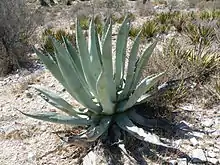Agave scabra
Agave scabra (synonym Manfreda scabra), also known as rough leaved agave, is a member of the subfamily Agavoideae.[1][2]
| Agave scabra | |
|---|---|
 | |
| Scientific classification | |
| Kingdom: | Plantae |
| Clade: | Tracheophytes |
| Clade: | Angiosperms |
| Clade: | Monocots |
| Order: | Asparagales |
| Family: | Asparagaceae |
| Subfamily: | Agavoideae |
| Genus: | Agave |
| Species: | A. scabra |
| Binomial name | |
| Agave scabra | |
| Synonyms[1] | |
| |
Description
Agave scabra has rosettes growing 0.7–1 metre (2.3–3.3 ft) in height and 1.5–2 metres (4.9–6.6 ft) in width.[2] It is similar in form to many other agaves. The rosettes are suckering.
The glaucous bluish-green leaves are mostly reflexed and rough (like sand-paper). The inflorescence is up to 4.5 metres (15 ft) in height, with yellow flowers during the summer.[2]
Distribution
It is native to the Chihuahuan Desert and surrounding regions, in northeastern Mexico and Texas.[2] It grows from 500–1,500 metres (1,600–4,900 ft) in elevation.[2]
References
This article is issued from Wikipedia. The text is licensed under Creative Commons - Attribution - Sharealike. Additional terms may apply for the media files.